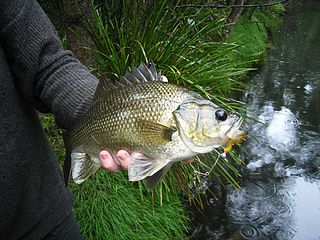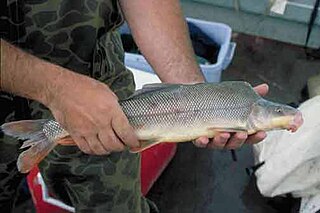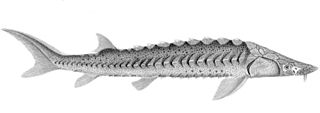
The Virgin River is a tributary of the Colorado River in the U.S. states of Utah, Nevada, and Arizona. The river is about 162 miles (261 km) long. It was designated Utah's first wild and scenic river in 2009, during the centennial celebration of Zion National Park.

Upper Klamath Lake is a large, shallow freshwater lake east of the Cascade Range in south-central Oregon in the United States. The largest body of fresh water by surface area in Oregon, it is approximately 25 miles (40 km) long and 8 miles (13 km) wide and extends northwest from the city of Klamath Falls. It sits at an average elevation of 4,140 feet (1,260 m).

The Napa River is a river approximately 55 miles (89 km) long in the U.S. state of California. It drains a famous wine-growing region called the Napa Valley, in the mountains north of the San Francisco Bay. Milliken Creek and Mt. Veeder watersheds are a few of its many tributaries. The river mouth is at Vallejo, where the intertidal zone of fresh and salt waters flow into the Carquinez Strait and the San Pablo Bay.

The Ogoki River is a river in the Thunder Bay and Cochrane Districts of Ontario. It springs from the wilderness just east of Savant Lake, flowing north of Lake Nipigon to Ogoki, where it joins the Albany River which empties into James Bay. The river is 480 kilometres (300 mi) long.

The yellow perch, commonly referred to as perch, striped perch or preacher is a freshwater perciform fish native to much of North America. The yellow perch was described in 1814 by Samuel Latham Mitchill from New York. It is closely related, and morphologically similar to the European perch ; and is sometimes considered a subspecies of its European counterpart.

The Australian bass is a small- to medium-sized species of primarily freshwater fish found in coastal rivers and streams along the east coast of Australia. A member of the genus Macquaria from the family Percichthyidae, the Australian bass is an important member of the native fish assemblages found in east coast river systems. It is a native predatory fish and an extremely popular game fish species among anglers. The species was simply called perch in most coastal rivers where it was caught until the 1960s, when the name "Australian bass" started to gain popularity.

The Klamath Project is a water-management project developed by the United States Bureau of Reclamation to supply farmers with irrigation water and farmland in the Klamath Basin. The project also supplies water to the Tule Lake National Wildlife Refuge, and the Lower Klamath National Wildlife Refuge. The project was one of the first to be developed by the Reclamation Service, which later became the Bureau of Reclamation.

The Tule Lake National Wildlife Refuge is a National Wildlife Refuge of the United States in northern California near the Oregon border. It covers 39,116 acres (15,830 ha) in the Tule Lake basin. It is part of the Klamath Basin National Wildlife Refuge Complex, and is a crucial part of the Pacific Flyway corridor for migratory birds.

The shortnose sucker is a rare species of fish in the family Catostomidae, the suckers. This fish is native to southern Oregon and northern California in the United States. It is a federally listed endangered species of the United States.

The Pacific lamprey is an anadromous parasitic lamprey from the Pacific Coast of North America and Asia. It is a member of the Petromyzontidae family. The Pacific lamprey is also known as the three-tooth lamprey and tridentate lamprey.

The razorback sucker is a suckerfish found in rivers and lakes in the southwestern United States and formerly northwestern Mexico. It can grow to 91 cm (3 ft) in length and is recognisable by the keel between its head and dorsal fin. It used to inhabit much of the Colorado River Basin but commercial fishing, river damming, and habitat loss have caused great declines in populations. It is now restricted to the Colorado River upstream of the Grand Canyon and to four reservoirs, Lake Mead, Lake Mohave, Lake Havasu, and Lake Powell.

The northern hogsucker is a freshwater ray-finned fish belonging to the family Catostomidae, the suckers. It is native to the United States and Canada where it is found in streams and rivers. It prefers clear, fast-flowing water, where it can forage on the riverbed for crustaceans, mollusks, aquatic insects, algae and detritus. It turns over small pebbles and scrapes materials off rocks and sucks up the particles, and other species of fish sometimes station themselves downstream from its activities so as to garner disturbed food fragments. Breeding takes place on gravel bottoms in shallow riffles in late spring. This fish is susceptible to such man-made disturbances as channelization, sedimentation, pollution, and dam construction. However, it has a wide range and is a common species so the International Union for Conservation of Nature has rated its conservation status as being of "least concern".

Fathead minnow, also known as fathead or tuffy, is a species of temperate freshwater fish belonging to the genus Pimephales of the cyprinid family. The natural geographic range extends throughout much of North America, from central Canada south along the Rockies to Texas, and east to Virginia and the Northeastern United States. This minnow has also been introduced to many other areas via bait bucket releases. Its golden, or xanthic, strain, known as the rosy-red minnow, is a very common feeder fish sold in the United States and Canada. This fish is best known for producing Schreckstoff.
The Colorado pikeminnow is the largest cyprinid fish of North America and one of the largest in the world, with reports of individuals up to 6 ft (1.8 m) long and weighing over 100 pounds (45 kg). Native to the Colorado River Basin of the southwestern United States and adjacent Mexico, it was formerly an important food fish for both Native Americans and European settlers. Once abundant and widespread in the basin, its numbers have declined to the point where it has been extirpated from the Mexican part of its range and was listed as endangered in the US part in 1967, a fate shared by the three other large Colorado Basin endemic fish species: bonytail chub, humpback chub, and razorback sucker. The Colorado pikeminnow is currently listed as vulnerable by the IUCN, while its NatureServe conservation status is "critically imperiled".

The green sturgeon is a species of sturgeon native to the northern Pacific Ocean, from China and Russia to Canada and the United States.

The Warner sucker is a rare species of freshwater ray-finned fish in the family Catostomidae. Native to Oregon in the United States and found only in the Warner Basin, its distribution extends just into Nevada and California. It is a federally listed threatened species. Its other common name is redhorse. The International Union for Conservation of Nature has rated this fish as an endangered species because of its small extent of occurrence, the small number of locations in which it is found, and the extreme fluctuations in area of occupancy resulting from drought and water abstraction. Conservation efforts have been put in place.

The spotted sucker is a species of sucker (fish) that is native to eastern North America. The spotted sucker inhabits deep pools of small to medium rivers over clay, sand or gravel. They are occasionally found in creeks and large rivers. Through its life stages, the spotted sucker goes from a mid-depth predator to a bottom forager. Spotted suckers have a lifespan of approximately six years and spawn in April and May. Limited knowledge of the occurrence, abundance, and natural history of this species has been an impediment to status assessment and the determination of need for conservation measures within this family.

The creek chubsucker is a freshwater fish of the sucker family (Catostomidae).

The lake chubsucker is a species of freshwater fish endemic to North America, found in the Great Lakes and the Mississippi River basin, as far north as Ontario, Canada, extending south to the Gulf of Mexico. It is mainly found in lakes, ponds, and swamps, rarely in streams.

Oregon & Northern California Coastal is a freshwater ecoregion in western North America. It includes the coastal rivers of Oregon and Northern California, from the Columbia River mouth in northwestern Oregon to northern Monterey Bay in Central California. It includes the Umpqua, Rogue, Smith River, Klamath, Mad, Eel, and lower Russian rivers, and many smaller coastal rivers and streams, including those on the coast side of the Marin and San Francisco peninsulas.





















